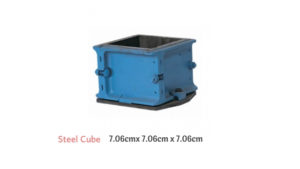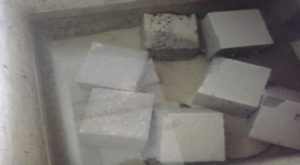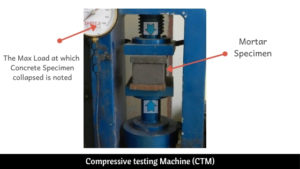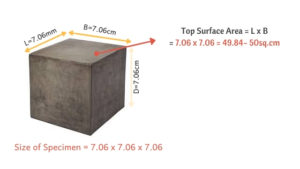The Compressive strength is the important basic data to be considered while selecting the cement for the construction.
As we already discussed the different grades of cement in our previous article, now let’s learn how to test the Compressive Strength of cement.
Contents
Compressive Strength of Cement:
Compressive strength is the capacity of material or structure to resist or withstand under compression. The Compressive strength of a material is determined by the ability of the material to resist failure in the form of cracks and fissure.
In this test, the impact force applied on both faces of Mortar specimen made with Cement and the maximum compression that cement specimen bears without failure recorded.

In Technical terms compressive strength of cement means,
The ability of cement specimen to resist the compressive stress when tested under Compressive Testing Machine [CTM] at 28 days.
Apparatus:
The apparatus required for testing Compressive Strength of cement is
- Compressive Test machine conforms to IS: 14858(2000)
- Steel cubes of 7.06cm moulds (50cm2 face area) conforming to IS: 10080-1982,

- Standard Sand is used for this testing conform to IS: 650-1966, the sand with no silt content and the sand which is passing through 2 mm IS sieve and retaining on 90 microns IS sieve and having a below particle size distribution is used. Standard Sand to be used in the test should have the below particle size distribution
Particle Size Percentage Greater than 1mm
(>1mm)33.33% Smaller than 1mm and greater than 500 microns 33.33% <500 microns 33.33% - Trowel to mix, Non-porous plate, Vibrator machine, Graduated cylinder, Weigh balance, Cement and water.
Procedure:
- Clean the apparatus with the dry cloth and ensure that the room temperature for conducting this test should be 27 ± 2°C
- Mix the cement and sand with the trowel for the period of 1 min on Non – porous plate. Ensure that the cement should not have any lumps in it
- Now add water and mix for 3 minutes until the paste is of uniform colour. The quantity of water mixed with the cement, the sand mixture should be
(P/4 + 3) % where P is the percentage of water required to produce the Standard consistency - Clean the mould with the dry cloth and apply the mould oil for easy removal of mortar cube after drying.
- Now pour the mortar in steel cube mould. Prod the mortar for 20 times in 8 sec with the help of rod to eliminate the entrained air.
- You can also use vibrator instead of a rod. The vibrator is played for the period of 2 mins with the speed 12000±400 vibrations /minute to eliminate the entrained air in mortar mix.
- Once the vibration completes, immediately remove the mould from the vibration machine and place it in room temperature for 24 hrs.
- Once mortar cube sets, After 24 hours dismantle the steel mould from mortar cube.
- Keep the test specimens submerged underwater for the stipulated time. This process is called curing.

- As mentioned the specimen must be kept in water for 7 or 14 or 28 days and for every 7 days the water is changed.
- Test the three cubes, one at 7th day, other at 14th day and another at 28th day.
- Testing specimens (mortar cubes) are placed in the space between bearing surfaces of the Compressive strength machine.
- Care must be taken to prevent the existence of any loose material or grit on the metal plates of machine or specimen block.

- The loading must be applied axially on specimen without any shock and increased at the rate of 35 N/mm2/min. till the specimen collapse.
- Due to the constant application of load on the face of the cube, the mortar cube starts cracking and fails at a point.
- Note down the reading from Compressive testing machine where the specimen starts failing.
The formula for calculating Compressive strength of cement is
The formula for calculating Compressive strength of cement is The maximum load carried by the mortar specimen (cube) which means the load point on Compressive testing machine at which the specimen starts breaking is divided with the surface area (contact area).

Example:
Assume the test specimen is of 28 days old and max compression load at which the specimen starts breaking is 165KN
As per above fig, Surface are is 50Sq.cm = 5000mm2
1 KN = 1000N = 165 x 1000 = 165000
As per formula,
Compressive strength of cement = 165000/5000 = 33N/mm2
Hence, the Grade of cement is 33 Grade
Observations:
| S.No. | Age of cube | Surface area of cube (mm2) | Max Load (N) | Compressive Strength N/mm2 | Average Compressive Strength N/mm2 |
|---|---|---|---|---|---|
| 1 | 7 days | ||||
| 2 | 14 days | ||||
| 3 | 28 days | ||||
Important notes: As per IS, at least three cubes are tested at 7 days, 14 days, 28 days and the average of the three cubes are rounded to nearest 0.5N/mm2 . Do not consider the specimen which differs more than 10% of the average value of compressive strength.
Results:
The average Compressive strength of cement cube at 7 days _________N/mm2
The average Compressive strength of cement cube at 14 days ________N/mm2
The average Compressive strength of cement cube at 28 days________N/mm2
Also Read:
How to find the Quality of cement on site
What is standard and normal consistency of cement
For Instant updates Join our Whatsapp Broadcast. Save our Whatsapp contact +919700078271 as Civilread and Send us a message “JOIN”
Never Miss an update Click on “Allow US” and make us allow or Click on Red notification bell at bottom right and allow notifications.
Civil Read Wishes you ALL the BEST for your future..



No Responses